In this article
What is PPBE?
There are three processes (Acquisition, Requirements, and Funding) supporting the Defense Acquisition System. The Planning, Programming, Budget, and Execution (PPBE) process, established by the Secretary of Defense (SECDEF), is one of these processes. The PPBE process focuses on Financial Management and resource allocation for Department of Defense acquisition programs. The SECDEF provides priorities and goals following the guidance of DoD Directive 7044.14 "Program Planning Budget & Execution (PPBE)" Process.
What are the phases of the PPBE cycle?
Planning: the first stage of PPBE
The planning phase is led by the Under Secretary of Defense for Policy, but the Chairman of the Joint Chiefs of Staff (CJCS) also plays a significant role in the planning process as the principal military advisor to the SECDEF under 10 U.S.C. §151. The CJCS advocates for solutions to department-wide requirements. During this phase the President's National Security Strategy (NSS), the SECDEF's National Defense Strategy (NDS), and the CJCS's National Military Strategy (NMS) are reviewed, ensuring that Defense Planning Guidance (DPG) developed from this process aligns with the Administration's policy goals, and potential threats, force structure, readiness structure and more are considered. The DPG provides guidance on investments and divestments for their services and is used in the development of their Program Objective Memorandum (POM)
Programming
The Director of the Cost Assessment and Program (CAPE) Office leads the programming phase, which is when predictions of the effects of today's decisions on the future force are analyzed. At the beginning of the phase, the heads of each military service and defense agency develop a Program Objective Memorandum (POM). The POM describes five years of proposed resource requirements such as forces, manpower, and funding for a program. The POM prioritizes and adjusts programs in the FYDP and can also outline risks associated with certain unfunded or underfunded programs. After the POMs for each service are submitted, CAPE leads the programs' reviews, forecasts five years of resource requirements and updates the FYDP. The SECDEF can then direct the services to make any necessary changes.

Budgeting
The Under Secretary of Defense (Comptroller)/Chief Financial Officer leads the budgeting phase. In this phase, the military services complete a Budget Estimate Submission (BES) for the FYDP's first year. The Comptroller reviews the budget submissions under guidance from the Office of Management and Budget (OMB). The Comptroller ensures that budget submissions are appropriately funded and have the right fiscal controls; phasing of efforts over the funding period; and feasibility of execution within the budget year. During this phase Comptroller analysts and service counterparts review budget requests to ensure they align with the unified defense budget. Then the SECDEF can direct the services to make any necessary changes. The final product should be submitted to OMG each December and included in the President's annual budget request in Congress. This budget request is usually submitted in February.
Execution
The execution phase also known as execution review evaluates program results to assess a program's actual performance compared to its planned performance. This process occurs simultaneously with the program review and the budget review. The program review prioritizes the programs that best meet strategic goals and takes into consideration any additional fiscal constraints. The budget review helps determine how much to spend on each program.
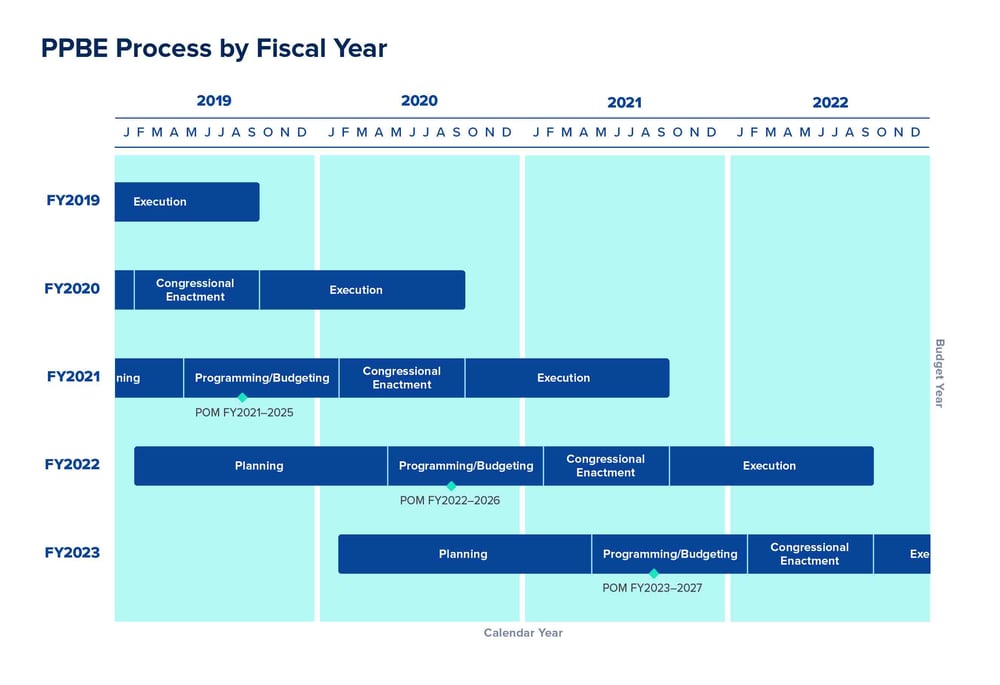
Who are the Key Players in the PPBE Process?
- USD for Research and Engineering (R&E) As the Department of Defense DOD chief technology officer, this role's responsibility is to advance technology and innovation for DOD and the military. During the PPBE process they must advise the SECDEF on all DOD research, engineering, and technology development activities and programs.
- USD for Acquisition and Sustainment (A&S) is responsible for determining all DOD elements that relate to acquisition including: the system's design, development, production, sustainment, and the acquisition of goods and services.
- USD for Personnel and Readiness (P&R) is responsible for advising on everything concerning the total force including active and reserve military, civilian, and contract support including addressing planning, requirements, readiness, workforce mix and balance, applicable personnel policies, and healthcare issues.
- Deputy Chief Management Officer (CMO) helps organize the department's business operations and is responsible for giving admin and managerial support to senior governance bodies.
- USD (I&S) - Intelligence and Security is responsible for advising on everything related to intelligence, counterintelligence, security, sensitive activities etc. The USD (I&S) also plays a key role in the intelligence budget process (IPPBE).
- DOD Chief Information Officer (CIO) is responsible for advising on major cyber investments, information technology (IT) resource allocations, and investment decisions. This includes providing recommendations on whether to continue, change or end IT investments.
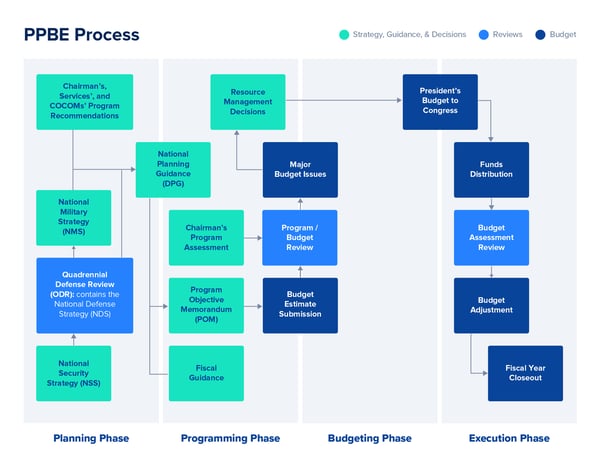
Inherent Challenges in the PPBE Process
Doing things the "right" way
There are major decisions to make on an annual basis regarding the allocation of billions of Federal dollars and the PPBE process is in place to manage this. However, with the broad array of national security challenges today, constrained budgets, and the uncertainty that comes with Continuing Resolutions (CR), there is more that could be done.
So much focus is placed on completing projects on budget and on schedule, but sometimes lost is determining whether the projects being done best align to the long-term mission objectives. To address this challenge's technical and organizational aspects art and science must be leveraged.
Aligning Interests
It is extremely difficult to collectively, across any enterprise, agree on priorities that get beyond the needs of individual, siloed organizations. Ultimately, the decision process must start with aligning interests across the enterprise. This is already a difficult process, but it gets even harder to do as you progress up the organizational hierarchy and more senior officials are advocating, often in an entrenched manner, for their specific programs. This is of course a natural byproduct of the massive bureaucracy that exists. However, when interests are aligned well then it allows major investments to become synchronized in concept, timing, and execution.
Dynamic and Time-Consuming
In addition to the challenge of making enterprise-focused decisions, the dynamic nature of these processes throughout a given decision cycle is an important variable. During each phase of the PPBE process, at varying levels of detail as each cycle progresses, decisions are made, changed, and changed again as organizations make (and modify) assumptions, and react to shifting guidance from higher-echelon organizations. Organizations at all levels struggle with the reaction time and "employee churn" required during these periods. Often the ratio of time spent reacting to changes in leadership guidance is on the order of 100:1, i.e., for a one-hour update to the decision-maker, the staff will spend 100 hours of prep work like updating spreadsheets and PowerPoint presentations until the message clearly conveys the proposed decision options. Underpinning this frustration are the long hours collecting new data, aggregating into common formats, getting updated proposals from subordinate organizations, synchronizing and re-messaging.
Challenges Today
Today, the challenges include budget constraints and ongoing competition among organizations to shape the way that our country addresses varying threats to our national security. Programs may lose funding as DoD attempts to balance competing priorities. Failure to provide detailed justification for funding may cause decision-makers to misjudge the importance of a program and reduce or eliminate its funds. In addition, the uncertainty created by Continuing Resolutions makes it very difficult for the Defense Department to plan and budget effectively.
Transitioning to the Opportunity and Change Management
Any adjustments to existing processes and decision-making cycles requires organizations to change. Volumes have been written regarding the methods of addressing organizational change. Change management intimidates organizations collectively and people individually. It connotes a major effort, with teams of consultants on the ground doing surveys, creating 80-slide PowerPoint presentations and often complex recommendations.
However, the experience and expertise to help drive an enterprise view already exists in your organization. To foster positive change, it is important that organizations are transparent in their process changes and that all changes are made iteratively, and gradually. The change process can be made smoother with good input from managers ultimately responsible for interpreting leaders' guidance and priorities.
Tools and Process
With everything necessary to help the process become more dynamic, it can seem that change in the PPBE process is a daunting task. However, there are tools available that can help you automate, find new ways to collaborate and new ways to organize the most important ideas of the organization in a clearly defined manner.
PPBE Process Modernization: How Decision Lens Can Help
At Decision Lens, we have been working with Federal customers on these challenges for over 15 years, and their continued feedback inspires each evolution of our product. From the early days, we have provided a unique capability to enable large organizations to develop a clear organizing construct for their decision-making processes, and to get leaders and subject matter experts to offer their judgments on the fundamental elements of the decision. Decision Lens has capabilities to enable organizations to balance their resources (dollars, people) within their most difficult investment decisions.
Rigor and Credibility
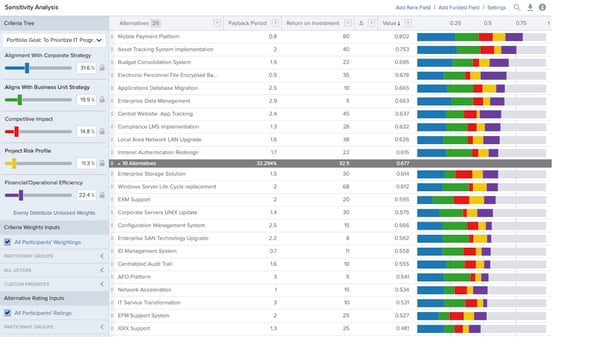
Decision Lens is designed to add rigor and credibility to any PPBE decision-making. By scoring different alternatives by how they align with various priorities, Decision Lens can be used to communicate how well those alternatives match strategic goals and help illuminate how best to allocate funding in order to get the most value per dollar. Decision Lens also can help with deciding how much to invest and when across large numbers of programs, offices, and funding pools, to help identify which tradeoffs to make.
Repeatability and Efficiency
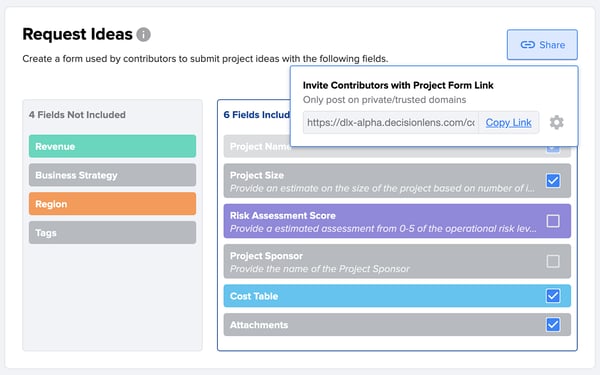
PPBE decisions are often made through mediums like spreadsheets, which are difficult to collaborate on, aggregate, or even just keep updated in the most basic ways. This makes them hard to reuse and incredibly inefficient. Decision Lens brings clarity to this otherwise frustrating process. By giving definition to the process, and including elements of collaboration and discussion, as well as the analytic side of decision making, Decision Lens helps one make the best decision quickly in a way that inspires confidence in the results. Decision Lens portfolios can also be reused and modified year after year to capture what worked before, yet be flexible enough to be updated with new information.
Traceability and Transparency
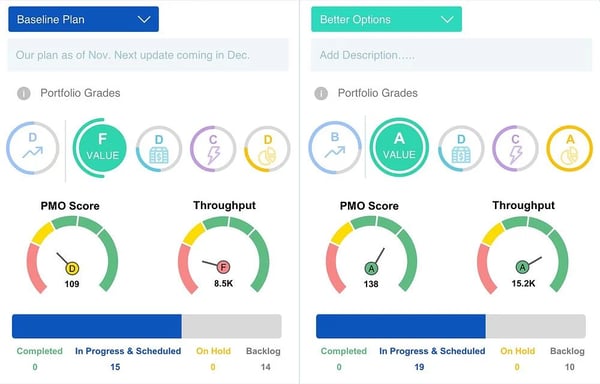
Decision Lens shows which alternatives best align with what priorities, and why those priorities are weighted the way that they are. The reasoning behind every decision is incredibly clear, making choices easy to both understand and justify. The collaborative and transparent process reduces risk, allowing for data-driven decisions that can be made with confidence and clarity. It also makes justifying choices easy by making clear the benefits of the chosen alternatives.
Want to learn more about how Decision Lens can help your PPBE process? Request a Demo today!




